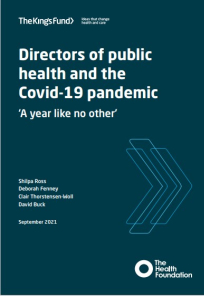Covid-19 reader: 24 September
Covid-19’s differential impact
Public Health England, Health profile for England 2021
 We remain in the throes of the pandemic and the focus is understandably on the here and now. How many people tested positive yesterday? How many people were admitted to hospital? And what is the latest daily death toll?
We remain in the throes of the pandemic and the focus is understandably on the here and now. How many people tested positive yesterday? How many people were admitted to hospital? And what is the latest daily death toll?
But while the time to assess the full cost of the pandemic is when it drops to a more background level, it is useful to look at Covid-19’s overall footprint to date. Public Health England recently published its Health profile for England 2021 report – its fourth such annual report. It not only gives a broad picture of the health of people in England today, but also summarises what the coronavirus pandemic’s (often differential) impact has been to date.
At the end of June this year, nearly 4.2 million confirmed cases of Covid-19 had been reported in England, with case rates higher in women than men. Case rates were highest in the North West, followed by London and the North East, higher in more deprived areas and, in terms of ethnic group, highest amongst those with an Asian background.
The UK’s highest seven-day average occurred in early January 2021, when the rate hit 881 per million population.
By the end of June, more than 132,000 deaths had been registered with Covid-19 mentioned on the death certificate. Again, there have been unequal impacts, with the death rate in the most deprived areas in England 2.4 times the rate in the least deprived. Men were 1.6 times more likely to have died than women. And the rate among those aged 85 and over was 3.2 times that for the 75- to 84-year bracket. The rates in black and Asian groups were more than double the rate in the white group.
With deaths, it is often more meaningful to look at excess mortality and here the data shows that between March and July, all-cause deaths in England were 1.14 times higher than expected, rising to 1.23 times higher in London. Rates were higher than expected for all age groups over 25. For deprived areas, the multiplier was 1.17 and deaths in black and Asian groups were close to 1.5 times higher than expected, compared to 1.12 in the white group.
Again, using slightly historical data to the end of June, 92% of those aged 50 and over had received both doses of vaccine, varying from nearly 95% to nearly 87% from the least deprived to the most deprived areas. There was also variation among ethnic groupings, with more than 90% of the white British and Indian ethnic groups double jabbed falling to less than 70% in the black African and black Caribbean groups. At that point the UK and the USA had the highest rates of second doses, based on rates for the whole population. Separate data from Our world in data shows that this is no longer the case with a number of European countries now with a greater proportion of their populations fully vaccinated including Portugal, Spain, Denmark, Ireland, Italy and France.
The coronavirus’s contribution to excess deaths
Office for National Statistics, August mortality analysis
More up-to-date commentary on Covid-related deaths came with the Office for National Statistics’ monthly mortality analysis for August. The analysis covers England and Wales and shows that the more than 40,000 deaths from all causes registered in England represented nearly a 10% increase on the August five-year average. In Wales, deaths were 4.8% above the average.
About one in 20 deaths (5.3%) in the month in England were due to Covid-19 – a larger proportion than in July (2.4%). Including deaths where Covid is mentioned on the death certificate, but is not the underlying cause increases the percentage to 6.1%.
The leading cause of death in the month was dementia and Alzheimer’s disease in England, accounting for 10.9% of all deaths. Covid was the third leading cause, also falling behind ischaemic heart disease (see bar chart). Heart disease was the leading cause in Wales, with Covid the seventh leading cause.
In England, five of the 10 leading causes of death were significantly lower than the five-year average. The mortality rate for deaths with an underlying cause of influenza and pneumonia was nearly 31% lower than the average for the month. This will be partly due to coronavirus restrictions and guidance, such as social distancing, reducing the spread of infections such as flu.
Looking at the whole of 2021, the leading cause of death in both countries has been Covid.
Nuffield Trust deputy director of research Sarah Scobie (pictured) said the excess deaths showed that the pandemic's heavy burden continued. ‘Cases are likely to rise as we enter the autumn and, given this will coincide with a time the NHS is under significant pressure, we should not lose sight of the continuing and tragic impact this virus is having on families up and down the country.’
Public health: when local is better than national
The King’s Fund, report
 Directors of public health played a crucial role in leading the local response to Covid-19, according to a new report from the King’s Fund. They were responsible for a wide range of health protection activities from testing in the community, to facilitating the uptake of the vaccine, to planning for the availability of food and emotional support for local people. Directors of public health and the Covid-19 pandemic: a year like no other points out that public health budgets, which since the Health and Social Care Act 2012 have sat with local authorities, have been cut significantly since 2015/16.
Directors of public health played a crucial role in leading the local response to Covid-19, according to a new report from the King’s Fund. They were responsible for a wide range of health protection activities from testing in the community, to facilitating the uptake of the vaccine, to planning for the availability of food and emotional support for local people. Directors of public health and the Covid-19 pandemic: a year like no other points out that public health budgets, which since the Health and Social Care Act 2012 have sat with local authorities, have been cut significantly since 2015/16.
The report, which is based on more than 50 interviews with public health directors, highlighted two main roles in the Covid response. Directors helped shape the response within regional and local emergency structures and committees. But they also worked more broadly to engage local communities, facilitate vital social support and act as a linchpin within the broader response.
It highlights key challenges including workforce shortages, and the fact that directors were not properly engaged by national government in the roll-out of NHS Test and Trace. Local directors did not have access to case-level data, which was a major constraint on their ability to contain outbreaks.
One director said that unless there was a need to do things at scale, then local was better and resources should be devolved. ‘The problem is that a national call centre has no understanding of the needs of the people living in our community, and no understanding of the support that’s available to people on offer… and a lack of sensitivity to build the relationships,’ they said. ‘[It]… isn’t going to have the community languages, whereas we can build a system and a team that can engage with our local community, understanding the languages that they speak.’
The King’s Fund said this contrasted with the Welsh approach, where public health directors (in health boards) had responsibility for the NHS Test, Trace and Protect system. This enabled ‘relatively better access and more direct ownership’.
The report also highlighted a disconnect in the testing programme. It said that central government had not engaged with directors well in terms of asking them to contribute to the shaping of the national testing strategy. But then directors had been expected to take responsibility for local implementation. One director described it as ‘always running to catch up with the government’, without having time to think how public health teams could support local businesses and people through initiatives such as rolling out mass testing.
Related content
We are excited to bring you a fun packed Eastern Branch Conference in 2025 over three days.
This event is for those that will benefit from an overview of costing in the NHS or those new to costing and will cover why we cost and the processes.